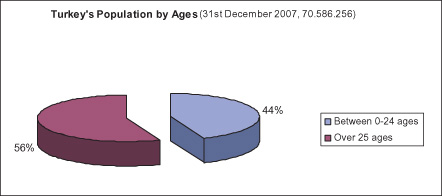
Figure 1: Population statistics and projections. Turkish Statistical Institute, TÜİK 2008.
This article draws a picture of the education system and library environment in Turkey. It starts off with a brief overview of the Turkish education system and the proportion of the population involved in formal and informal education. As 44% of the Turkish population is under 25, there is a big demand for higher education in Turkey. This demand drives the authorities to open new universities and provide higher education for more young people. 54 new universities have been established since 2000. University librarians try to cope with this rapid increase and create functional libraries. Librarians have started to cooperate closely within the framework of ANKOS (Anatolian University Libraries Consortium) since 2000. ANKOS is one of the successful examples of library consortiums.
Turkey has quite a young population. As of 31 December 2007, the population of Turkey totals 70.5 million, of which 44% (31 million people) are under the age of 25 (Figure 1).

As a result of such a young population, a sizeable part of the community is directly or indirectly involved in educational activities. In the 2007/2008 academic year, there are 14,817,654 students and 647,312 teachers in pre-university formal education, and 5,117,623 students and 87,285 teachers in non-formal education. In addition, there are 2.5 million students and 98,766 teaching staff in higher education including the Open University. In total, there are 22,467,899 students and 833,363 teachers in formal and non-formal education. As a result, 23.3 million people, which make up 33% of the population, are de facto involved in the schooling/education process (Figure 2).

After the foundation of the Republic of Turkey, Istanbul University was established in 1933 as the first university of the republican era. Until the 1950s there were only three state universities, i.e., Istanbul, Istanbul Technical and Ankara Universities. In 2008 however, there are 127 universities in the Turkish educational system. Of these, 94 are state and 33 are foundation (or private) universities.
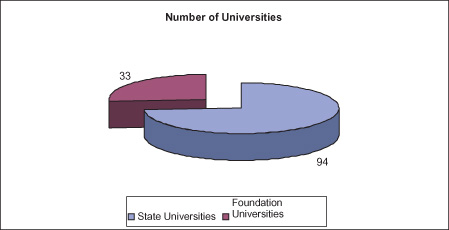
A third of these universities are quite newly established: 54 were been established after the year 2000 and 87 are less than 20 years old (Figure 4).
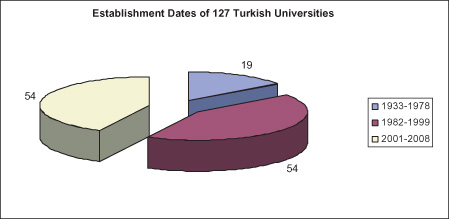
Universities in Turkey are organised under the Council of Higher Education. With the 1981 Higher Education Law (Law No. 2547) higher education started undergoing an academic, organisational and administrative restructuring. With this law, all higher education institutions were assembled under The Council of Higher Education (YÖK), academies were changed to universities, educational institutes to education faculties and conservatories and vocational colleges were affiliated to universities. Hence, the Council of Higher Education became the sole fully autonomous corporate public body in control of higher education in accordance with the provisions set forth in Articles 130 and 131 of the Constitution and the Higher Education Law.
As explained above, there are more than 22 million students at all levels of the education system, from pre-school to doctorate level. The higher education institutions have about 1.6 million students (excluding the Open University) in the 2007–2008 academic year (Figure 5).
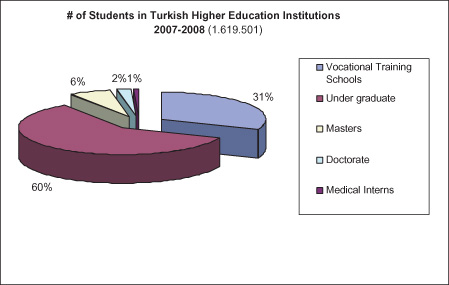
There are 89,329 teaching staff at the universities. Old, established universities have the necessary number of teaching staff, but until the need of the newly established universities for personnel is fulfilled, it is unavoidable that there will be transfers from old to new universities. The present number of teaching staff by academic title is shown in Figure 6.
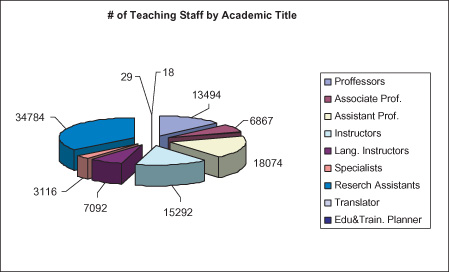
Together with the newly opened ones, the number of academic units, such as faculties, institutes and graduate schools within universities is 2,148. The distribution of academic units by type is shown in Figure 7.
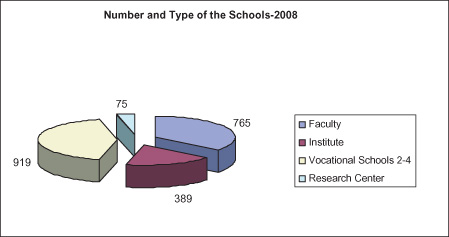
As explained above, Turkey has a very young population and there is an enormous demand for higher education. Each year around 2 million young people take the university entrance exam, and of these only around 590,000 can be placed in universities, including the Open University and vocational schools.
The number of people placed in a four-year programme, not counting the Open University, is 205,000. In view of the great demand for universities, coupled with the fact that universities liven up economic activity in the region, it has become attractive to governments to establish universities. Most universities in Turkey were established very recently: only 28 out of 127 universities are older than 20 years. As more universities were founded, the need for libraries grew also, but often there was not enough funding to establish a library right away.
Particularly the libraries of newly opened universities have inadequate funding for acquisition of publications, personnel and library buildings, and so should be specially supported.
Some statistics on state university library budgets can be found in Figure 8; these are published annually in the Official Gazettes. No similar statistics are available for foundation (private) universities, but it is well-known that they have similar funding problems.
In 2008, the appropriation from the national budget for 85 state universities totals 7,290,705,650YTL (5.6 billion USD). Of this, 45,096,000YTL (34.7 million USD) was allocated to collection building, equalling 0.61% of the overall budget for universities. State universities generate revenues themselves in addition to the funding they receive from the national budget. Of the 85 state universities, 14 have over 1 million YTL for acquiring publications. Foundation universities are in a similar situation, but the figures are not given here as their budgets are not published.
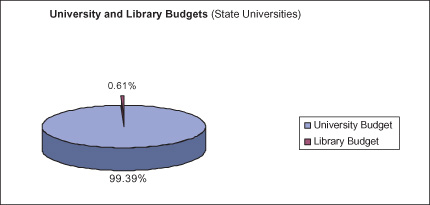
When compared to libraries in Europe and America, most university libraries in Turkey operate with much fewer staff. According to a survey we conducted in 2007, the average number of staff in university libraries is 18 per university. The average number of professional staff is 6 per library (Figures 9 and 10).
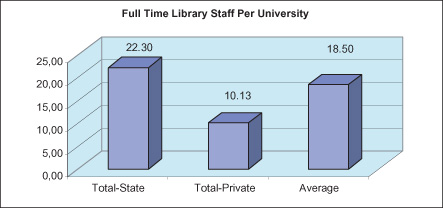

It is apparent that the number of staff per library will decrease even further when the staff from the 44 newly opened universities is added to this figure. As can be seen, university librarians have to provide the same services with fewer staff than their European or American colleagues.
Despite the inadequacies they face, from 2000 onwards, university libraries joined forces under ANKOS (Anatolian University Libraries Consortium), and created a successful mode of cooperation in the acquisition of e-publications and subscriptions. This structure, formed by voluntary cooperation, is made up of an administrative board, work and research groups and database liaisons. Even libraries with the smallest budget have been enabled to offer their users access to thousands of periodicals. ANKOS is run by around 50 volunteers from university libraries. This type of cooperation is being maintained successfully despite some difficulties.
Starting from 2006, TÜBİTAK-ULAKBİM (The Scientific and Technological Research Council of Turkey-Turkish Academic Network and Information Center) has started paying for some of the subscriptions out of its own budget. This initiative to provide university libraries which had insufficient funds with additional revenue was a positive step in supporting university libraries financially. However, it would be more appropriate for this financial support to be transferred to university libraries with the decisions on its use left to the libraries. We believe that strengthening the position of libraries and their becoming the most important unit of a university is the common goal of all concerned.
With the effort from 2000 onwards, university libraries have access to world famous publishers’ journals. As a result of talks with publishers, access was granted to all universities that wanted it at optimum conditions. Some of the publishers to whose publications access was acquired through ANKOS are Elsevier, Springer, Wiley, Blackwell, Taylor and Francis, IEEE, Cambridge University Press, Oxford University Press, Sage, SIAM, American Chemical Society, American Institute of Physics, Institute of Physics, and Emerald.
In 2007, ANKOS realised 992 subscriptions to 50 databases offered by 32 publishers or vendors for 86 members (Figure 11).
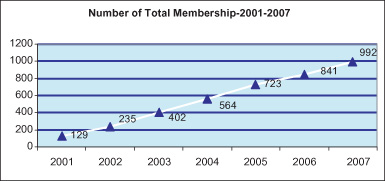
The number of full-text articles accessed from these databases has increased in parallel to the number of subscriptions, and in 2006 it reached 11.2 million (Figure 12). It is estimated that these numbers increased even more in 2007. We do not have the figures for 2007 as the full statistics were not available at the time of this study.
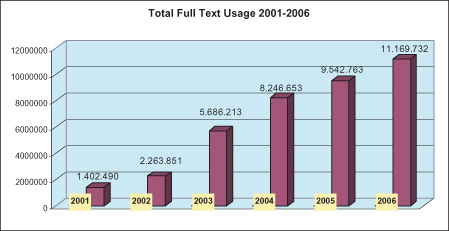
A substantial portion of full-text article usage concerns five major journal databases. In 2006, nearly 8 million articles were downloaded from these databases which contain over 5,000 journals (Figures 13 and 14). The number of universities subscribed to these databases increased in 2007, and it is expected that usage will increase substantially in parallel.
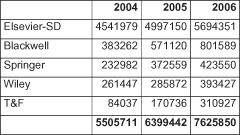
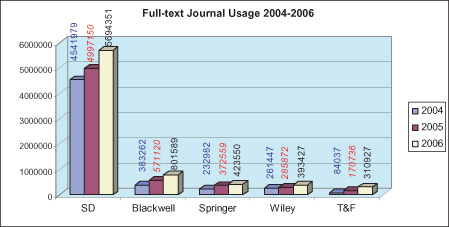
Statistics for usage of full-text databases are given in Figure 15. As can be seen from the graph, the Science Direct database is the most widely used database. This is unfavourable for other databases which offer journal equal in scientific quality to those of SD. Libraries should put more effort into promoting use of other databases as well.

After securing access to the collections of journals from important publishers, university libraries have started working on e-book acquisitions and subscriptions. Books from publishers such as Elsevier, Springer, and Blackwell and databases of books such as Ebrary and Safari are being used by numerous university libraries.
At the same time university libraries are working on orientation, user education and information literacy to enable productive usage of their resources.
Another subject that university libraries are working on is opening up their universities’ institutional archives to access by users. Various university libraries have started opening up their publications, in different formats, for use over the internet using software like Eprint and Dspace. In addition, a number of university libraries are working on digitisation of rare library materials.
One of the areas of cooperation which is working well between university libraries is InterLibrary Loan (ILL). The ANKOS Collaboration Research Group is engaged in an effort so that ILL procedures between university libraries could be carried out through a common interface. Furthermore, it is planned to deliver ILL services through a database formed by the union catalogue being prepared with the participation of the University and Research Librarians’ Association (ÜNAK).
University librarians have started participating in national and international professional meetings and conferences more and are organising international professional conventions in Turkey. After the 1995 IFLA conference in Istanbul, organised by the Ministry of Culture, in which university librarians were active participants, ANKOS, with the participation of university librarians, has been organising annual meetings on an international level starting from the year 2000. In 2003, the IATUL (International Association of Technological University Libraries) conference was held at the Middle East Technical University (ODTÜ). And, of course, the 2008 Annual General Conference of LIBER was hosted by Koç University's Suna Kiraç Library in July, enabling university librarians to develop their professional expertise and organisational skills even more.
In conclusion, it is apparent that university libraries, when compared with the advanced libraries of the world, need to improve themselves with regard to their budgets, staff and printed collections. However, it is observed that Turkish university libraries are on a par with those in Europe and America when it comes to access to electronic resources, and that they are keeping up with the developments and making them available to their users. With the technological infrastructure established in the university libraries, users have 24/7 access to the world's most important scientific publications. These developments have started to affect positively research and publication performance, specifically by long-established universities with their infrastructure already in place. From a study published by ULAKBİM in 2008, it can be seen that 63.7% of the 179,179 articles that made it into the SCI, SSCI and A&HI reference indexes that were in Web of Science between 1981–2006, originated from Ankara, Istanbul and Izmir. 33.13% of the total number of publications were realized by five universities: Hacettepe University, Istanbul University, Ankara University, Middle East Technical University (ODTÜ) and Istanbul Technical University (İTÜ). The first three of these have faculties of medicine and 50.32% of the 179,179 publications were in the medical and life sciences disciplines. In the engineering discipline, 30.92% of the total number of publications were realised by İTÜ, ODTÜ and Bosphorus University.
It can be expected that with the increase of electronic access capabilities, this will change in the near future. For the newly established universities in Anatolia to reach the upper levels in the list, it is necessary to improve their infrastructure, to increase the numbers of researchers and teaching staff, and to improve academicians’ and librarians’ foreign language abilities, because a major part of scientific literature is published in English and in electronic format. To be able to compete with the rest of the world in research and innovation Turkish universities have to continue their efforts to create better library environments.
With these goals in mind, university libraries and librarians are reorganising in parallel to the innovations and changes in information technologies. We can say that this process, which gained momentum in 2000, will accelerate in the coming years.
Translated by: Ali Orbay.
|
2007–2008 academic year higher education statistics, ÖSYM, 2008, www.osym.gov.tr.
|
|
ANKOS statistics, ANKOS online website, www.kutuphane.itu.edu.tr/ankos.
|
|
Central authority 2008 budget law No.5724. Official Gazette 28.12.2007..
|
|
Educational statistics. Turkish Statistical Institute, TÜİK., 2008, http://www.tuik.gov.tr.
|
|
Establishment dates of universities and attached units. The Council of Higher Education, YÖK. 2008, http://www.yok.gov.tr.
|
|
Population statistics and projections. Turkish Statistical Institute, TÜİK., 2008, http://www.tuik.gov.tr.
|
|
Scientific publication map of Turkey. TÜBİTAK-ULAKBİM, Ankara, 2008. ISBN 978-975-403-448-6.
|
|
Towards The European Higher Education Area Bologna Process, Template For National Reports 2004–2005. Aybar Ertepinar and others.
Higher Education Council, www.yok.gov.tr/duyuru/bolonya_sureci.doc.
|